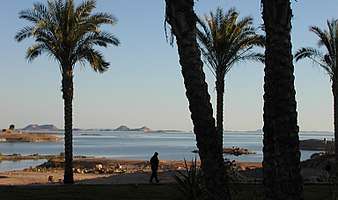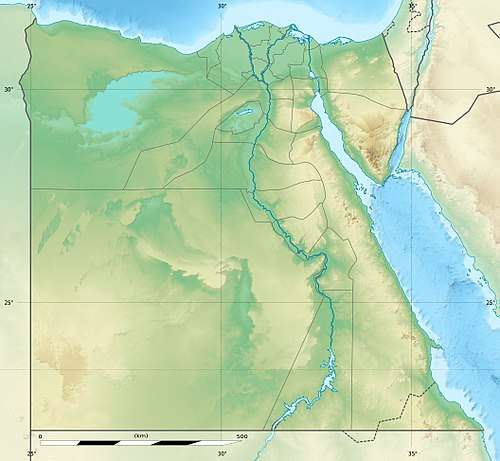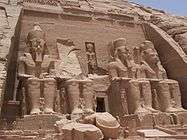Lake Nasser
Lake Nasser (Arabic: بحيرة ناصر Boħēret Nāṣer, Egyptian Arabic: [boˈħeːɾet ˈnɑːsˤeɾ]) is a vast reservoir in southern Egypt and northern Sudan. It is one of the largest man-made lakes in the world.[2] Before construction, Sudan was against the building of Lake Nasser because it would encroach on land in the North, where the Nubian people lived. They would have to be resettled.[3][4] In the end Sudan's land near the area of Lake Nasser was mostly flooded by the lake.[5]
| Lake Nasser | |
|---|---|
 View from Abu Simbel | |
 Lake Nasser | |
 Map showing the location of the lake | |
| Coordinates | 22°25′N 31°45′E |
| Lake type | Reservoir |
| Primary inflows | |
| Primary outflows | |
| Basin countries | Egypt, Sudan |
| Max. length | 550 km (340 mi) |
| Max. width | 35 km (22 mi) |
| Surface area | 5,250 km2 (2,030 sq mi) |
| Average depth | 25.2 m (83 ft) |
| Max. depth | 130 m (430 ft) |
| Water volume | 132 km3 (32 cu mi)[1] |
| Shore length1 | 7,844 km (25,735,000 ft) |
| Surface elevation | 183 m (600 ft) |
| 1 Shore length is not a well-defined measure. | |
Strictly, "Lake Nasser" refers only to the much larger portion of the lake that is in Egyptian territory (83% of the total), with the Sudanese preferring to call their smaller body of water Lake Nubia (Egyptian Arabic: بحيرة النوبة Boħēret Nubeyya, [boˈħeːɾet nʊˈbejjæ]).[6]
Description
The lake is some 479 km (298 mi) long and 16 km (9.9 mi) across at its widest point, which is near the Tropic of Cancer. It covers a total surface area of 5,250 km2 (2,030 sq mi) and has a storage capacity of some 132 km3 (32 cu mi) of water.[7]
The lake was created as a result of the construction of the Aswan High Dam across the waters of the Nile between 1958 and 1970.[8] The lake is named after Gamal Abdel Nasser, one of the leaders of the Egyptian Revolution of 1952, and the second President of Egypt, who initiated the High Dam project. It was President Anwar Sadat who inaugurated the lake and dam in 1970.[9]
Current issues
Egypt lacks the water it needs for agriculture and electricity. [10] The Grand Ethiopian Renaissance Dam, currently being constructed in Ethiopia, will most likely adversely affect the water monopoly granted by colonial powers which effectively left Ethiopia and other upstream nations out of the picture. While the Renaissance Dam will benefit Sudan and Ethiopia, it has caused tensions between Egypt and Sudan and Ethiopia. Egypt is worried that the new dam will stop the Nile River from adequately filling Lake Nasser.[11] The water supply of Lake Nasser produces electricity, and there is concern that diminishing water flowing into Lake Nasser will adversely affect the Aswan Dam's ability to generate electricity. There are pumping stations that control the water going into Lake Nasser, and currently this project generates 10 billion kilowatt-hours of hydroelectric power each year to Egyptians.[12]
Sport and tourism
A fish enclosure was built in Lake Nasser.[13] Fishing among tourists, especially for Nile perch, has become increasingly popular, both on the shore and from boats.[14][15] Although the Abu Simbel and other temples were physically moved[16] to higher ground and to different sites to prevent their destruction by the new lake, other ancient Egyptian sites, like the massive fortress of Buhen, were flooded and are now underwater. The statues of Ramses II and others, at Abu Simbel Temple, look out over Lake Nasser [17] and tourists can enjoy the view from their cruise ship.[18]
Gallery
 Panoramic view of Lake Nasser
Panoramic view of Lake Nasser Panoramic view of Lake Nasser at dawn
Panoramic view of Lake Nasser at dawn View of Abu Simbel from Lake Nasser
View of Abu Simbel from Lake Nasser
Further reading
- Helen Chapin Metz. Egypt: A Country Study. Washington: GPO for the Library of Congress, 1990., Helen Chapin Metz, ed.
References
- "Lake Nasser". World Lake Database. Retrieved 15 October 2016.
- "Aswan High Dam, River Nile, Sudan, Egypt". Water Technology. Retrieved 15 October 2016.
- Scudder, Thayer (September 2, 2016). Aswan High Dam Resettlement of Egyptian Nubians. Springer. ISBN 9789811019357. Retrieved 18 November 2016.
- Sofer, Amon (1999). Rivers of Fire: The Conflict Over Water in the Middle East. Rowman & Littlefield. p. 36. ISBN 9780847685110.
- "Governorates of Egypt". Statoids Administrative Divisions of Countries ("Statoids"). Retrieved 16 October 2016.
- Roest, F.C.; Crul, R. C. M. (1995). Current Status of Fisheries and Fish Stocks of the Four Largest African Reservoirs: Kainji, Kariba, Nasser/Nubia and Volta. Food & Agriculture Org. p. 81. ISBN 9789251036839.
- Muala, Eric; Mohamed, Yasir A.; Duan, Zheng; van der Zaag, Pieter (August 13, 2014). "Estimation of Reservoir Discharges from Lake Nasser and Roseires Reservoir in the Nile Basin Using Satellite Altimetry and Imagery Data". Remote Sensing. 6 (8): 7526. Bibcode:2014RemS....6.7522M. doi:10.3390/rs6087522.
- "Life-Giving Nile River (Aswan Dam, Egypt)". National Geographic. 2012-12-20. Retrieved 15 October 2016.
- Encyclopedia of Architectural and Engineering Feats. ABC-CLIO. 2001. p. 23. ISBN 9781576071120.
president nasser, high dam project.
- "Egyptian agriculture crisis worsens, mainly due to lack of water". Daily News Egypt. September 27, 2016. Retrieved 16 October 2016.
- "Water Politics - Sharing the Nile". The Economist. January 16, 2016. Retrieved 15 October 2016.
- "Life-Giving Nile". National Geographic. 2012-12-20. Retrieved 15 October 2016.
- Habib, Dr. O.A.; Shehata, M.; Zaki, M.; Ammar, H.; Rahman, Dr. S.H. Building fish enclosure in Lake Nasser. Lake Nasser Development Authority. Retrieved 15 October 2016.
- "Nile Perch Fishing on Lake Nasser". Trip Advisor. Retrieved 15 October 2016.
- Vartorella, Bill (2002). "Egyptology fellowship chairman shares giant fish story". The Rotarian. 180 (6): 14. Retrieved 15 October 2016.
- Gohary, Jocelyn (1998). Guide to the Nubian monuments on Lake Nasser. American University in Cairo Press. ISBN 9789774244629. Retrieved 15 October 2016.
- Maroon, Fred J.; Newby, Percy Howard (1979). The Egypt story: Its art, its monuments, its people, its history. Chanticleer Press Edition. p. 42.
- "Lake Nasser Cruise". Lake Nasser Cruise. Retrieved 15 October 2016.
External links
| Wikimedia Commons has media related to Lake Nasser. |